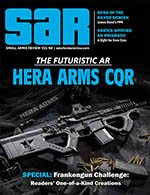Vortex Spitfire AR Prismatic: Between a Scope and a Red Dot Sight
By Oleg Volk
Vortex Spitfire AR prismatic scope bridges the gap between red dot sights and scopes. An unmagnified sight with an integral AR-height riser, it uses an etched reticle of two concentric circles around a 3MOA center dot. The centerline of Spitfire AR is 1.575 inches above the Picatinny rail surface. Windage and elevation turrets graduated in 0.5MOA clicks are capped, but a spare turret graduated with 5.56x45mm BDC out to 700 yards is included for uncapped use.
While the optic has a wide 23-degree angle of view, it’s generally used with both eyes open, making that feature less critical. Spitfire eye relief is 3.7 inches, with a generous eyebox, but not infinite as with red dots. What does it gain over the red dots that makes up for the loss of unlimited eye relief?
First and foremost, the black etched reticle makes it useful without batteries. The sight may be deployed without being turned on and can function in the coldest weather. With the etched reticle as the projection backing, Spitfire has 6-step daylight bright illumination in red or green. The color and the brightness are controlled with two buttons on the back of the integral riser mount. A quick press on both switches color, a long press shuts the illumination off. As a backup for the absent-minded, a 14-hour timer also turns off illumination on an inactive scope. Single AAA battery life is decent but not spectacular at about 250 hours (full power) or 3,000 on the dimmest setting. For long-term storage, lithium AAA batteries are recommended. At the brightest setting, Spitfire is useful for shooting aerial targets like clays. The concentric circles also work very well for leading aerial clays with straight stock shotguns like MKA1919 or Origin 12.
The view through this scope is brighter than on a typical red dot sights, as the front lens doesn’t have to be tinted. Also unlike red dot sights, the prismatic scope causes fewer problems with undercorrected astigmatism in the shooter’s eyes. I am not sure why that’s the case, but numerous people have noticed that unmagnified prismatic scopes don’t suffer from reticle distortion in very low light, when the pupil opens fully and begins to use the less corrected peripheral vision.
The reticle subtensions, 140MOA on the outer circle, correspond to twice the height of an adult male, so a typical foe would fit in that circle at 50 yards, or between the center dot and the top at 100. The inner circle is 44MOA. The center dot is 3MOA, but the absence of light bloom makes it feel smaller. With no vertical or horizontal reference, the reticle is definitely intended for short-range use but can be pressed into service for distance if necessary. Since the rifle front sight usually remains visible at the bottom of the optic, it serves as an expedient cant reference. In my experience, the reticle is detailed enough to facilitate 100-yard, off-hand head hits and 300-yard deliberate torso shots with 5.56mm carbines. The center dot gives a slightly more precise aiming point with the illumination off, but the light bloom is minimal even at full brightness. At distances below 75 yards, placing the highly visible inner ring around the torso of the foe is very quick and almost guarantees a hit. In theory, +/-60MOA of elevation adjustment enable hitting area targets out to 1200 yards with 5.56x45mm ball, but the center dot covers the width of a typical human at 400 yards.
While backup sights remain visible through the optic in the lower 1/3 of the image circle, the front sight will not be in focus. It can be used for rough emergency aiming, but not as true co-witnessing. However, the most robust construction of Spitfire makes it likely to outlast folding mechanical sights. When stowed, the glass is protected with flip-up caps. All connections are sealed with O-rings, and the optics are nitrogen-filled to prevent internal fogging. The single piece tube housing and riser remove yet another potential failure point.
My experience with Spitfire began with the older, turn-dial model. I still prefer the dial to buttons for gloved use, but plenty of competent people prefer buttons. The battery compartment is definitely easier to use on the new model. It has seen extensive use on a Tavor SAR carbine. It is ideal for pistol caliber carbines and other short-range long guns with straight stocks. At this time, I run Spitfire AR on a shotgun, a 22WMR carbine and a 5.56mm rifle. The usability and the moderate price make it practical for use as a standard, across-the-board sight for most short- to medium-range long guns with straight stocks.
Samples of the updated design for this review were provided by Small Arms Review, Vortex and Optics Planet, from which it is and other optics are available with a 5% discount (code Volk5 at checkout).
This article first appeared in Small Arms Review V21N8 (October 2017) |
| SUBSCRIBER COMMENT AREA |
Comments have not been generated for this article.







